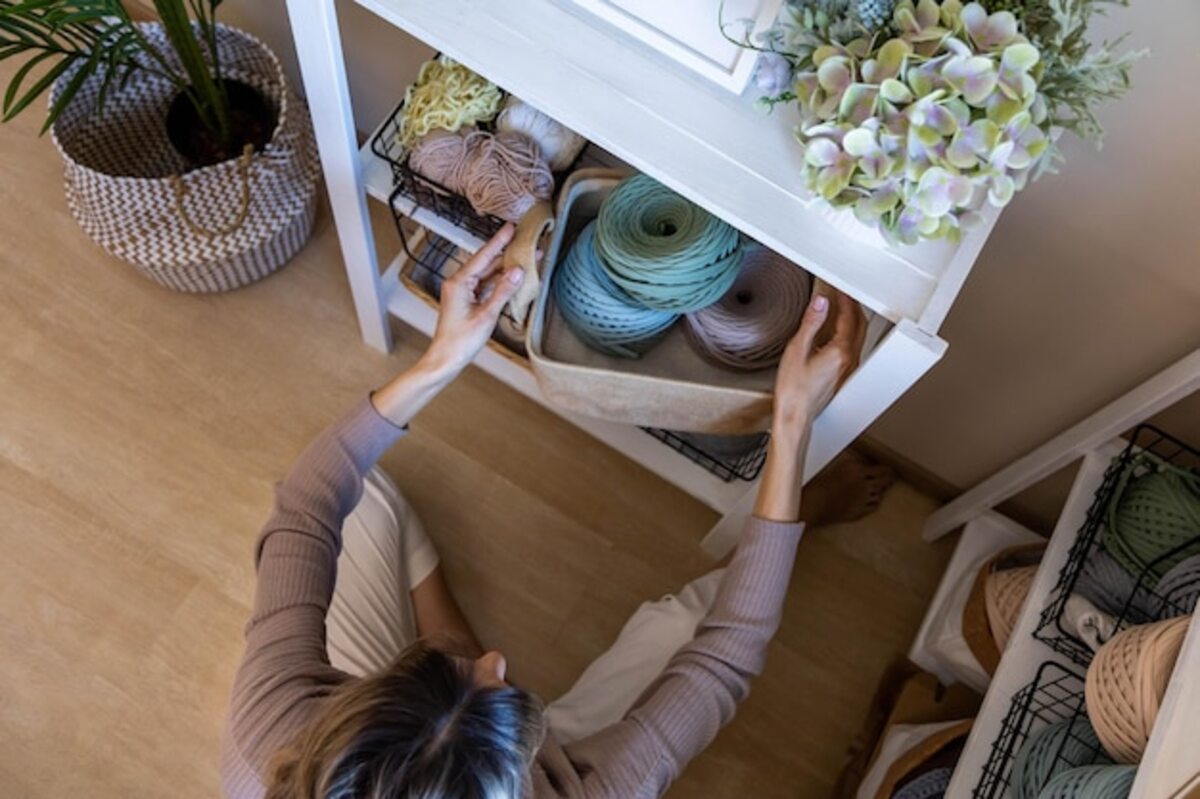Intuitive organization for a home that flows with life

Organizing your home intuitively not only optimizes space but also invites life and positive energy to flow in every corner. In this article, you will discover how to transform your house into a harmonious refuge where every object has its place and each area breathes tranquility. With simple yet effective strategies, you will achieve an environment that stimulates creativity and well-being. Give your home a makeover and feel the difference!
The importance of an intuitive organization at home
The intuitive organization in the home plays a fundamental role in creating an environment that not only looks good but also functions efficiently. When spaces are organized in a logical and accessible way, each family member can move easily and find what they need effortlessly. This reduces frustration and stress, allowing each day to flow more harmoniously. Furthermore, an organized home invites creativity and facilitates concentration, as it eliminates the visual distractions that often accompany clutter.
Beyond functionality, an intuitive organization also impacts our mental and emotional health. Having a space where each object has its place fosters a sense of control and inner peace. This order not only improves our daily quality of life but also creates a welcoming environment for receiving friends and family with warmth. A well-organized home is like a blank canvas: it allows energy to flow freely and inspires us to enjoy the present, thus promoting a more balanced and fulfilling life.
2. Basic principles for creating functional spaces
To create functional spaces that promote intuitive organization, it is essential to consider the principle of accessibility. This involves placing the objects and tools you use most often in strategic locations, where they are easy to reach and use. For example, in the kitchen, the most frequently used utensils should be at eye level and within easy reach, while those that are used less often can be stored on upper shelves or in the back of drawers. This arrangement not only optimizes the available space but also reduces the time spent searching for things, thereby promoting a more fluid and harmonious environment.
Another key principle is zoning, which involves dividing each area of the home according to its specific function. By establishing clear zones for activities like cooking, working, or relaxing, you make it easier for each family member to know exactly where to find what they need and how to interact with the space. Using multifunctional furniture can also be a great help; for example, a sofa bed can transform a living room into a cozy place to host guests overnight. By implementing these basic principles, your home will not only be more practical and efficient, but also a place where everyone feels comfortable and connected.
3. How to select the essentials: the art of simplifying
When tackling the organization of your home, it is essential to learn to distinguish between what is essential and what is superfluous. The art of simplifying begins with an honest review of your belongings: ask yourself which ones are truly necessary and which ones merely take up space. To do this, you can implement the "three piles" method: keep, donate, and discard. This approach will not only help you reduce the number of items in your home, but it will also create a lighter and more welcoming environment. At the end of the process, each item you decide to keep should add value to your life or have a special meaning for you.
Once you have selected the essentials, it's time to find a suitable place for each item. Intuitive organization is based on ease of access and functionality; so group similar items together and place them in areas where you need them most frequently. For example, kitchen utensils should be near the cooking area, while office supplies can be organized on the desk. Remember that every corner matters: even small changes can make a big impact on how energy flows within your home, allowing each day to be a refreshing and enjoyable experience.
4. Organization techniques for each room of the home
To achieve an intuitive organization in every room of the home, it is essential to adapt storage techniques to the specific needs of each space. In the kitchen, for example, consider using drawer organizers that separate utensils and tools according to their daily use. Grouping similar items not only facilitates access but also minimizes visual clutter. Likewise, in the living room, using open shelves can be an excellent solution to display books and decorations that add personality to the environment while keeping them accessible and tidy.
In bedrooms, investing in solutions like under-bed boxes or decorative baskets for clothes can help maintain a calm and clear environment. The key is to create specific zones for each type of belonging; for example, designate an area for personal accessories and another for seasonal clothing. Finally, in bathrooms, opt for floating shelves or mobile caddies that allow easy access to essential products without sacrificing style. With these techniques adapted to each room, your home will not only look organized but will also promote a sense of peace and harmony in your daily life.
5. The influence of order on our emotional state
The connection between physical order and our emotional state is undeniable. A disorganized home can create feelings of chaos, stress, and anxiety, while a clean and well-organized space promotes mental peace and serenity. By adopting an intuitive approach to organizing every corner of your house, you are not only creating a visually pleasant environment but also cultivating an atmosphere that encourages mental and emotional clarity. When every object has its place, distractions are reduced, and greater concentration on daily activities is favored.
Moreover, the act of organizing is not just physical; it is also a ritual of self-care. By dedicating time to tidy your space, you are dedicating time to yourself and your emotional well-being. This process can be deeply therapeutic: by getting rid of excess and sorting the essentials, you allow new energies to flow into your life. Intuitive organization invites a positive energy that can influence how you feel day by day, fostering a sense of control over your environment that translates into confidence and emotional stability. With each shining corner of order, you feel how the weight of clutter fades away, making room for new opportunities and a fuller life.
6. Tools and practical solutions for organizing small spaces
Practical tools and solutions for organizing small spaces are key to maximizing every corner of your home. Start with the implementation of vertical shelves that make the most of the height of your walls; this will not only free up floor space but also allow you to display books, plants, or decorations that bring life to your environments. Additionally, consider using stackable boxes and organizers in closets and under beds; these elements are ideal for storing less frequently used items, keeping everything accessible and tidy. The key is to find solutions that fit your specific needs and are functional without sacrificing your style.
Another effective strategy is to incorporate multifunctional furniture, such as ottomans with internal storage or extendable tables that adapt to different situations. These pieces allow for greater flexibility in space usage and facilitate the quick transformation of an area as needed. Likewise, do not underestimate the power of hooks and coat racks: they are excellent allies for keeping essentials visible while avoiding clutter. With these practical tools, you can create an organized environment where every element has its place, allowing energy to flow freely throughout your home, contributing to a more harmonious and pleasant atmosphere.
7. Strategies for maintaining order in the long term
To maintain long-term order, it's essential to establish daily routines that integrate organization into your everyday life. Spend a few minutes each day reviewing and relocating items that have been taken out of their place. This simple habit prevents clutter from accumulating and helps you create a more harmonious environment. For example, at the end of the day, take a moment to return books, toys, or kitchen utensils to their designated places. Over time, these small actions become a natural part of your routine, making it almost automatic to maintain order.
Another key strategy is to assign a specific place for each category of items and ensure that all household members know and respect those spaces. Use labels or colorful containers to facilitate identification and encourage collaboration in home organization. Additionally, conduct regular reviews of your belongings; getting rid of what you no longer need not only frees up physical space but also mental space. By keeping only what you truly value and use, you will be creating a lighter and more fluid environment where each item serves a meaningful purpose in your daily life.
8. Personalizing the organization according to your lifestyle
Customizing the organization of your home is key to making it truly work with your lifestyle. Each person has different routines, interests, and needs, so a standard organization may not be enough. Think about how you use each space: if you enjoy cooking, make sure your utensils and spices are within reach and in a place that inspires you to prepare delicious dishes. If you work from home, create a workspace that motivates you, with decorative elements that reflect your personality and organizational tools that facilitate workflow. By adapting the layout according to your daily habits, you can keep things orderly effortlessly.
Leveraging the potential of your environment also means recognizing which objects are truly significant to you. Get rid of the things that no longer have a place in your life or that don't resonate with you. This will not only free up physical space but also emotional space. Consider implementing creative solutions like decorative boxes or open shelves where you can display your favorite books or special memories. By personalizing each corner with what you love and need, you will create a unique home that respects you and enhances your positive energy, thereby facilitating an environment conducive to creativity and daily well-being.
9. Creating specific areas for daily activities
Creating specific zones for daily activities is a fundamental key in the intuitive organization of your home. By establishing designated areas for tasks such as reading, working, or exercising, you not only optimize the use of space but also help your mind associate each place with a specific purpose. For example, a cozy nook with a comfortable chair and good lighting can become your reading sanctuary, while a clear area with a functional table can serve for your creative or work projects. In this way, each activity becomes a more enjoyable and productive ritual.
By creating these specific zones, you foster an environment where energy flows uninterrupted. It can be helpful to use decorative elements, such as plants or inspiring pictures, that not only beautify the space but also reinforce the purpose of each area. This transforms your home into a place where every corner invites action and relaxation as needed. Intuitive organization allows each family member to feel comfortable and motivated by knowing exactly where to carry out their daily activities, thus contributing to a harmonious flow that enhances the overall well-being of the home.
10. Visual inspiration: examples of successfully organized homes
Visual inspiration is key for those looking to organize their home effectively and attractively. Observe examples of spaces where functionality and aesthetics come together in perfect harmony: from minimalist kitchens with tidy pantries to living rooms that invite relaxation thanks to a careful use of color and space. Imagine open shelves where each object not only serves a purpose but also adds character to the environment. By observing these setups, you can find ideas that resonate with you and motivate you to implement tangible changes in your own home.
Organized homes often reflect a balanced lifestyle. For example, in a well-designed bedroom, clothes are sorted by categories and colors, creating a serene atmosphere that promotes rest. Reading nooks are well-lit and have accessible shelves for favorite books. Each element has been carefully selected to contribute to the flow of the space, allowing for easy and pleasant circulation. Borrowing this visual inspiration not only transforms your physical environment; it can also positively influence your mental state, fostering a sense of peace and well-being in your daily life.



